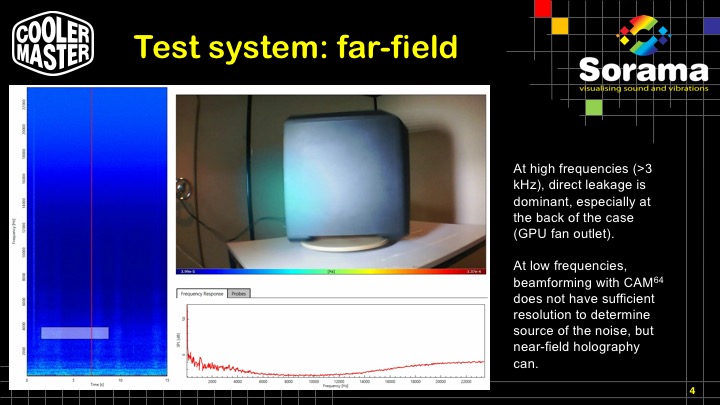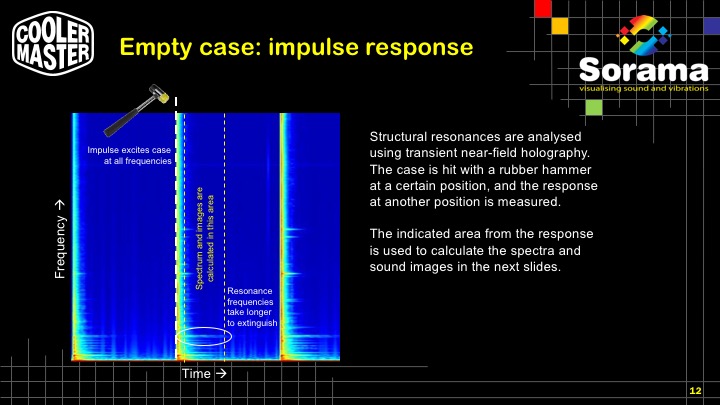Sorama's System Turns Precise Sound & Vibration Measurements Into IR-Like Images
Sorama is a Dutch company that specializes in the acoustics field. To be more precise, Sorama's CEO and founder Rick Scholte (PhD), found a way to create a special camera which is able to visualize noise and vibration sources up to half a millimeter. The images that the camera creates allow the discovery of noise sources faster than any other conventional method.
The images that the Sorama system delivers look like the images from an infrared (IR) camera, with the major difference being that instead of temperature, the Sorama cameras identify noise. For a good indication of how this system might be used, scroll down to the bottom, where we have an example from Cooler Master.
This is something truly innovative and to the best of our knowledge only Bruel & Kjaer offers a similar noise mapping system. However, that system doesn't look to be as accurate as Sorama's implementation. For those interested in knowing more about noise source identification and sound field visualization, here is an interesting paper on the subject.
This system has huge potential since it can be used in almost every engineering field, from automotive and aerospace to electronics and IT, providing the ability to find noise and vibration sources with great precision. In electronics, for example, you can spot unwanted resonances which indicate a bad design or a problematic component, while at the same time you can find electronic noise (AKA coil whine) sources. In automotive, you could thoroughly check the engine and the chassis. There are so many potential uses for tech like this, it's tough to think of them all.


The camera that Sorama had in its Computex booth was the entry level CAM64, which costs less than $3,200. The CAM64 can be used for near or far-field sound imaging, covering the 1Hz - 20kHz range in near field and the 300Hz-20kHz range with optimal conditions at 1.2kHz - 15kHz for far-field measurements. There is also a higher-end camera available, the CAM1K, which can cover a larger area thanks to the increased number of microphones that it's equipped with.
Leave the full (and confusing) technical specifications aside, what is a product like the CAM64 actually useful for? As we already stated, this camera is able to visualize noise, meaning that it produces images where the noise levels are clearly represented on the image or video, and scales sound according to a color code. If you reading the images and understanding the results, Sorama offers a service that handles this for you.
Say that you have a circuit and you need to identify the component that produces the noise/vibrations in order to identify the problem, Soroma's near-field imaging will analyze the output and help you pinpoint and fix the problem.
Get Tom's Hardware's best news and in-depth reviews, straight to your inbox.
Given the description that we got from Sorama's CEO, the only downside that we can see in that the sound imaging system isn't fully independent, meaning that the results need post processing from a cloud service that Sorama offers. In order for your results to be processed, you need to have a subscription with Sorama and buy credits, which are used to pay for the services that they will offer.
According to Sorama, this credit system is fair for the companies that use its products. But personally, we believe that such a system eventually restricts engineers, since they will have to use the service selectively, in order to avoid excess cost. This credit system actually reminds us of the days of decades past, when computers weren't widely accessible so you had to buy time slots to use them.
We asked Sorama why they don't provide the post-processing software to users, and if they plan to do so in the future. His response was that the company wants to keep control of the whole process. As we see it, Sorama is probably afraid that somebody else will get the software and manage to reverse-engineer it, since the magic of this sound mapping system lives in its algorithm, not to the camera and the microphones that it utilizes.
Moreover, it's of course more profitable to tie your customers to a subscription. Adobe and Microsoft have moved in a similar direction in recent years. This way, all customers will have to keep close ties with Sorama. Software costs aside, the initial price of the CAM64 is very low for such a tool. Specifically, the cost is 2708 euros (about $3,200 USD), and the membership to Sorama's portal is about $30 per month. If you're the type of company that needs these kinds of readings, that cost is quite low.
Sorama's sound imaging implementation is truly innovative. It should provide a huge advantage in every lab and engineering facility, as much as we don't like the subscription and credits system, particularly for those who would otherwise use such a system heavily.
For far-field results, which aren't as accurate, Sorama says you don't need to spend any credits. But this isn't the case for important (and generally more useful) near-field scans. Nonetheless, the system that Sorama offers has great potential and the low cost of the required equipment provides a chance to more companies and labs to give it a try and decide whether it makes sense for their workflow and budget.
In order to fully understand this system and its strengths and weaknesses, we'll need to spend some serious time with it in our lab. Only then will we fully understand its capabilities and potential, especially in the IT field. Until then, we can say for sure that Sorama has a promising product and service here. And we're clearly not the only ones interested; major brands like Philips, Samsung, Cooler Master and others are working with the company.
Case Study - Sound Imaging And Design Using A Cooler Master MasterCase MC500P
For a better real-world example of the system and how it might be used, the following photos show how Cooler Master used the Sorama system to improve not only the MasterCase MC500P, but all of its chassis. We got special permission from Cooler Master to use this file and we thank Cooler Master's CEO Jimmy Sha for the files--and Sorama of course for informing us from the start about this interesting example of the company's tech in action.























Aris Mpitziopoulos is a contributing editor at Tom's Hardware, covering PSUs.
-
derekullo Guidance system for my desktop mounted Laser Fly Defense Platform.Reply
You may not want to hum while nearby. -
bit_user Thanks for the article, but the specs are inconsistent in use of mm vs. cm.Reply
Imagine musical instrument makers being able to replicate the structural resonance of the best examples...



